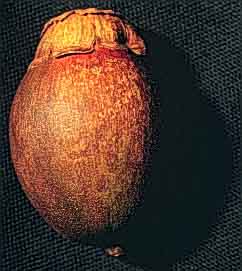
Bactris major Jacq.
Guis coyol
(Arecaceae)
|
Bactris major Jacq. Guis coyol (Arecaceae) | |
Espinoza, R., Guadamuz, A., Perez, D., Chavarría, F. and Masís, A. 1998. Bactris major (Arecaceae) Species Page, May 13, 1998. Species Home Pages, Area de Conservación Guanacaste, Costa Rica. http://www.acguanacaste.ac.cr
Palm from 1-10 m tall and 2- 6 cm in diameter (Henderson et al., 1995).
Flower:
Rachis of the infl. 14 cm; rachilla (3) 510 (17),
1423 cm long. Masculine fls. from 3-8 mm. long. Femanine fls. from
48 mm. long (Grayum 1997).
Fruit:
Immature fruits are brownish white. Mature fruits are brown with an eliptical shape. The pulp of the mature fruit is blackish-purple It is edible and has a tart flavor.
|
Immature fruit |
Mature fruit |
|
Sectioned immature fruit | |
|
Seeds | |
Leaves:
The lámina is pinnadamenttly compound and has aproximatly 45-48 leaflets. Spiny rachis.
|
Upper surface of blade |
Under surface of blade |
|
Detail of upper surface |
Detail of under surface |
|
Upper surface of leaflet |
Under side of leaflet |
|
Spines on the rachis | |
Bark and wood:
The shoots are very spiney and aggregate.
|
Shoot |
Transversal cut of shoot |
Whole plant architecture:
|
Aspect of the habitat |
Similar species:
All of the other bactris, but the fruit of most are bigger and are different in color.
Verification:
Old namoes for this species are: Bactris augustinea L. H. Bailey; Bactris
balanoidea (Oerst.) H. Wendl.; Pyrenoglyphis balanoidea (Oerst.) H. Karst.;
Bactris superior. L. H. Bailey.
II.Geographic distribution:
International:
Watersheds of the Atlantic and Pacific in all of Central America and north of South America (Henderson et al. 1995).
In Costa Rica:
Watersheds of the Atlantic and Pacific, 0-50 (-100) m (Grayum 1997).
In the Area de Conservación Guanacaste:
Lowlands of the Atlantic and Pacific watersheds.
Map of macro-habitats of the
ACG |
III. Natural History:
IV. How to find:
It is common in the San Emilio Forest of the Santa Rosa Sector and on the road to Playa Naranjo near the estuary.
Acknowledgments.
This project was carried out by the Area de Conservación Guanacaste/CR, with help from INBio/CR, ICBG from the Foggarty center, NIH/USA and NSF/USA.
Literature cited:
Henderson, A., Galeano, G. & Bernal.R. 1998. Field Guide to the Palms of the Americas. Princeton University Press. Princeton, New Jersey.
Grayum, M.H. 1997. Arecaceae. Manual de la Flora de Costa Rica. En preparación.